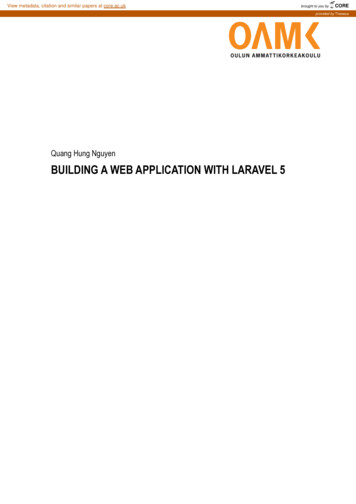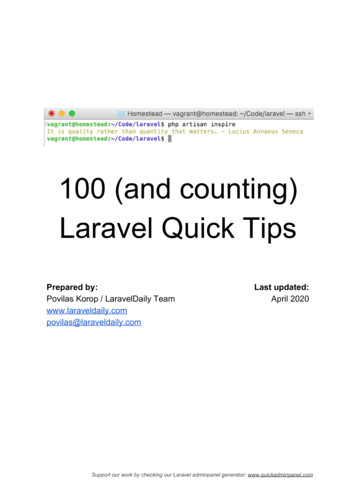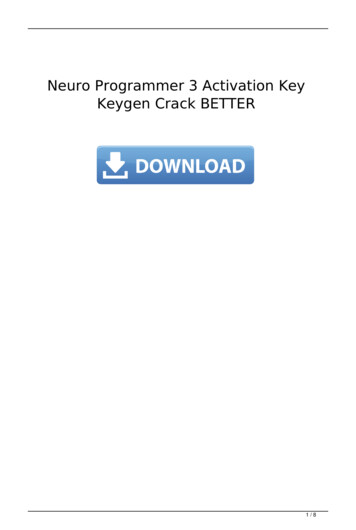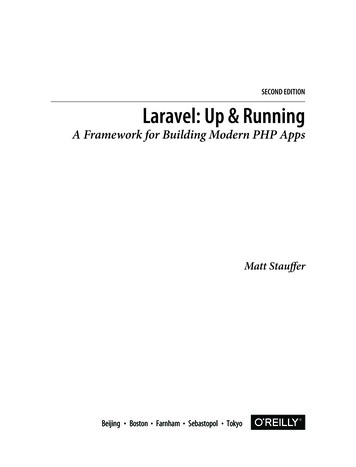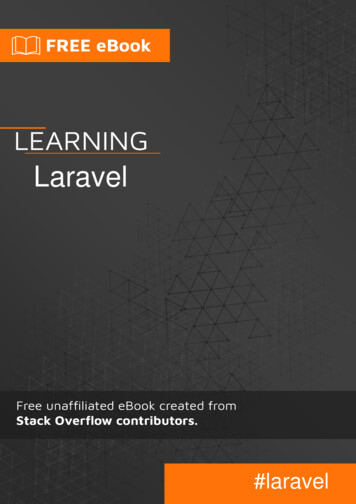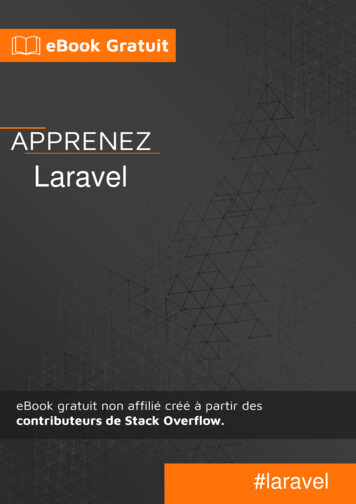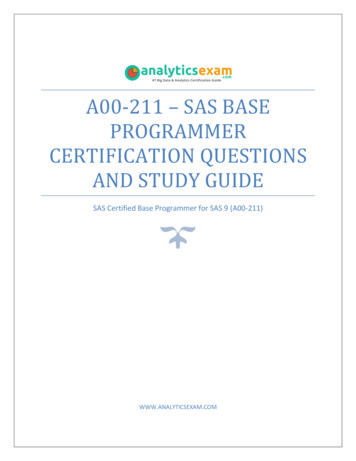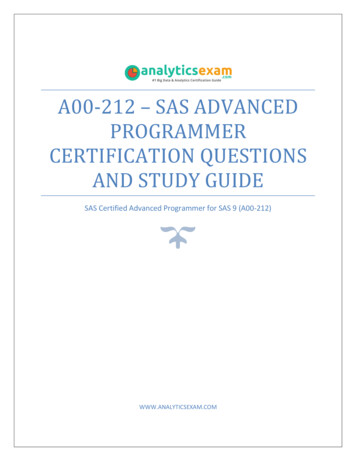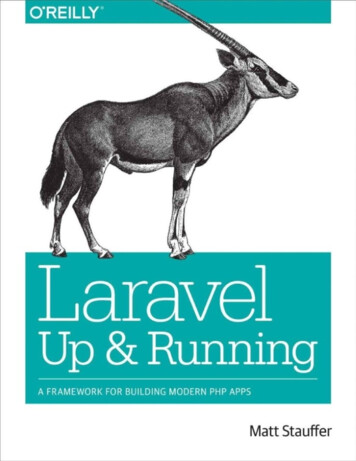
Transcription
Laravel: Up and RunningA Framework for Building Modern PHP AppsMatt Stauffer
Laravel: Up and Runningby Matt StaufferCopyright 2017 Matt Stauffer. All rights reserved.Printed in the United States of America.Published by O’Reilly Media, Inc., 1005 Gravenstein Highway North, Sebastopol, CA 95472.O’Reilly books may be purchased for educational, business, or sales promotional use. Onlineeditions are also available for most titles (http://oreilly.com/safari). For more information,contact our corporate/institutional sales department: 800-998-9938 or corporate@oreilly.com.Editor: Allyson MacDonaldProduction Editor: Colleen LobnerCopyeditor: Rachel HeadProofreader: Kim CoferIndexer: Angela HowardInterior Designer: David FutatoCover Designer: Randy ComerIllustrator: Rebecca DemarestDecember 2016: First Edition
Revision History for the First Edition2016-11-14: First ReleaseSee http://oreilly.com/catalog/errata.csp?isbn 9781491936085 for release details.The O’Reilly logo is a registered trademark of O’Reilly Media, Inc. Laravel: Up andRunning, the cover image of a gemsbok, and related trade dress are trademarks of O’ReillyMedia, Inc.While the publisher and the author have used good faith efforts to ensure that the informationand instructions contained in this work are accurate, the publisher and the author disclaim allresponsibility for errors or omissions, including without limitation responsibility fordamages resulting from the use of or reliance on this work. Use of the information andinstructions contained in this work is at your own risk. If any code samples or othertechnology this work contains or describes is subject to open source licenses or theintellectual property rights of others, it is your responsibility to ensure that your use thereofcomplies with such licenses and/or rights.978-1-491-93608-5[LSI]
DedicationThis book is dedicated to my gracious and inspiring wife, Tereva, my joyful and courageousson, Malachi, and my beautiful daughter, Mia, who spent the majority of this book’s creationin her mama’s belly.
PrefaceThe story of how I got started with Laravel is a common one: I had written PHP for years, butI was on my way out the door, pursuing the power of Rails and other modern webframeworks. Rails in particular had a lively community, a perfect combination of opinionateddefaults and flexibility, and the power of Ruby Gems to leverage prepackaged common code.Something kept me from jumping ship, and I was glad for that when I found Laravel. Itoffered everything I was drawn to in Rails, but it wasn’t just a Rails clone; this was aninnovative framework with incredible documentation, a welcoming community, and clearinfluences from many languages and frameworks.Since that day I’ve been able to share my journey of learning Laravel through blogging andspeaking at conferences; I’ve written dozens of apps in Laravel for side and work projects,and I’ve met thousands of Laravel developers online and in person. I have plenty of tools inmy toolkit at our consultancy, but I am honestly happiest when I sit down in front of acommand line and type laravel new project.
What This Book Is AboutThis is not the first book about Laravel, and it won’t be the last. I don’t intend for this to be abook that covers every line of code or every implementation pattern. I don’t want this to bethe sort of book that goes out of date when a new version of Laravel is released. Instead, itsprimary purpose is to provide developers with a high-level overview and concrete examplesto learn what they need to get started, as quickly as possible. Rather than mirroring the docs, Iwant to help you understand the foundational concepts behind Laravel.Laravel is a powerful and flexible PHP framework. It has a thriving community and a wideecosystem of tools, and as a result it’s growing in appeal and reach. This book is fordevelopers who already know how to make websites and applications and want to quicklylearn how to do so in Laravel.Laravel’s documentation is thorough and excellent. If you find that I don’t cover anyparticular topic deeply enough for your liking, I encourage you to visit the onlinedocumentation and dig deeper into that particular topic.I think you will find the book a comfortable balance between high-level introduction andconcrete application, and by the end you should feel comfortable writing an entire applicationin Laravel, from scratch. And, if I did my job well, you’ll be excited to try.
Who This Book Is ForThis book assumes knowledge of basic object-oriented programming practices, PHP (or atleast the general syntax of C-family languages), and the basic concepts of the Model–View–Controller (MVC) pattern and templating. If you’ve never made a website before, you mayfind yourself in over your head. But as long as you have some programming experience, youdon’t have to know anything about Laravel before you read this book — we’ll covereverything you need to know, from the simplest “Hello, world!”Laravel can run on any operating system, but there will be some Bash (shell) commands in thebook that are easiest to run on Linux/Mac OS. Windows users may have a harder time withthese commands and with modern PHP development, but if you follow the instructions to getHomestead (a Linux virtual machine) running, you’ll be able to run all of the commands fromthere.
How This Book Is StructuredThis book is structured in what I imagine to be a chronological order: if you’re building yourfirst web app with Laravel, the early chapters cover the foundational components you’ll needto get started, and the later chapters cover less foundational or more esoteric features.Each section of the book can be read on its own, but for someone new to the framework, I’vetried to structure the chapters so that it’s actually very reasonable to start from the beginningand read until the end.Where applicable, each chapter will end with two sections: “Testing” and “TL;DR.” If you’renot familiar, TL;DR means “too long; didn’t read.” These final sections will show you how towrite tests for the features covered in each chapter and give a high-level overview of whatwas covered.The book is written for Laravel 5.3, but because Laravel 5.1 is the latest LTS release, anyfeatures that are new in 5.2 or 5.3 will be identified.
Conventions Used in This BookThe following typographical conventions are used in this book:ItalicIndicates new terms, URLs, email addresses, filenames, and file extensions.Constant widthUsed for program listings, as well as within paragraphs to refer to program elementssuch as variable or function names, databases, data types, environment variables,statements, and keywords.Constant width boldShows commands or other text that should be typed literally by the user.Constant width italicShows text that should be replaced with user-supplied values or by values determined bycontext.T IPThis element signifies a tip or suggestion.NOT EThis element signifies a general note.WARNINGThis element indicates a warning or caution.
O’Reilly SafariNOTESafari (formerly Safari Books Online) is membership-based training and reference platformfor enterprise, government, educators, and individuals.Members have access to thousands of books, training videos, Learning Paths, interactivetutorials, and curated playlists from over 250 publishers, including O’Reilly Media, HarvardBusiness Review, Prentice Hall Professional, Addison-Wesley Professional, Microsoft Press,Sams, Que, Peachpit Press, Adobe, Focal Press, Cisco Press, John Wiley & Sons, Syngress,Morgan Kaufmann, IBM Redbooks, Packt, Adobe Press, FT Press, Apress, Manning, NewRiders, McGraw-Hill, Jones & Bartlett, and Course Technology, among others.For more information, please visit http://oreilly.com/safari.
How to Contact UsPlease address comments and questions concerning this book to the publisher:O’Reilly Media, Inc.1005 Gravenstein Highway NorthSebastopol, CA 95472800-998-9938 (in the United States or Canada)707-829-0515 (international or local)707-829-0104 (fax)We have a web page for this book, where we list errata, examples, and any additionalinformation. You can access this page at http://bit.ly/laravel-up-and-running.To comment or ask technical questions about this book, send email tobookquestions@oreilly.com.For more information about our books, courses, conferences, and news, see our website athttp://www.oreilly.com.Find us on Facebook: http://facebook.com/oreillyFollow us on Twitter: http://twitter.com/oreillymediaWatch us on YouTube: http://www.youtube.com/oreillymedia
AcknowledgmentsThis book would not have happened without the gracious support of my amazing wife Terevaor the understanding (“Daddy’s writing, buddy!”) of my son Malachi. And while she wasn’texplicitly aware of it, my daughter Mia was around for almost the entire creation of the book,so this book is dedicated to the whole family. There were many, many long evening hours andweekend Starbucks trips that took me away from my family, and I couldn’t be more gratefulfor their support and also their presence just making my life awesome.Additionally, the entire Tighten Co. family has supported and encouraged me through thewriting of the book, several even editing (Keith Damiani, editor extraordinaire) and helpingme with challenging code samples (Adam Wathan, King of the Collection Pipeline). DanSheetz, my partner in Tighten crime, has been gracious enough to watch me while away manya work hour cranking on this book and was nothing but supportive and encouraging; andDave Hicking, our operations manager, helped me arrange my schedule and workresponsibilities around writing time.Taylor Otwell deserves thanks and honor for creating Laravel — and therefore creating somany jobs and helping so many developers love our lives that much more. He deservesappreciation for how he’s focused on developer happiness and how hard he’s worked to haveempathy for developers and to build a positive and encouraging community. But I also want tothank him for being a kind, encouraging, and challenging friend. Taylor, you’re a boss.Thanks to Jeffrey Way, who I still contend to be one of the best teachers on the Internet. Heoriginally introduced me to Laravel and still introduces more people every day. He’s also,unsurprisingly, a fantastic human being whom I’m glad to call a friend.Thank you to Jess D’Amico, Shawn McCool, Ian Landsman, and Taylor for seeing value inme as a conference speaker early on and giving me a platform to teach from. Thanks to DayleRees for making it so easy for so many to learn Laravel in the early days.Thanks to every person who put their time and effort into writing blog posts about Laravel,especially early on: Eric Barnes, Chris Fidao, Matt Machuga, Jason Lewis, Ryan Tablada,Dries Vints, Maks Surguy, and so many more.And thanks to the entire community of friends on Twitter, IRC, and Slack who’ve interactedwith me over the years. I wish I could name every name, but I would miss some and then feelawful about missing them. You all are brilliant, and I’m honored to get to interact with you ona regular basis.Thanks to my O’Reilly editor, Ally MacDonald, and all of my technical editors: KeithDamiani, Michael Dyrynda, Adam Fairholm, and Myles Hyson.And, of course, thanks to the rest of my family and friends, who supported me directly orindirectly through this process — my parents and siblings, the Gainesville community, otherbusiness owners and authors, other conference speakers, and the inimitable DCB. I need to
stop writing because by the time I run out of space here I’ll be thanking my Starbucks baristas.
Chapter 1. Why Laravel?In the early days of the dynamic web, writing a web application looked a lot different than itdoes today. Developers then were responsible for writing the code for not just the uniquebusiness logic of our applications, but also each of the components that are so commonacross sites — user authentication, input validation, database access, templating, and more.Today, programmers have dozens of application development frameworks and thousands ofcomponents and libraries easily accessible. It’s a common refrain among programmers that,by the time you learn one framework, three newer (and purportedly better) frameworks havepopped up intending to replace it.“Just because it’s there” might be a valid justification for climbing a mountain, but there arebetter reasons to choose to use a specific framework — or to use a framework at all. It’sworth asking the question: why frameworks? More specifically, why Laravel?
Why Use a Framework?It’s easy to see why it’s beneficial to use the individual components, or packages, that areavailable to PHP developers. With packages, someone else is responsible for developing andmaintaining an isolated piece of code that has a well-defined job, and in theory that person hasa deeper understanding of this single component than you have time to have.Frameworks like Laravel — and Symfony, Silex, Lumen, and Slim — prepackage acollection of third-party components together with custom framework “glue” likeconfiguration files, service providers, prescribed directory structures, and applicationbootstraps. So, the benefit of using a framework in general is that someone has madedecisions not just about individual components for you, but also about how those componentsshould fit together.
“I’ll Just Build It Myself”Let’s say you start a new web app without the benefit of a framework. Where do you begin?Well, it should probably route HTTP requests, so you now need to evaluate all of the HTTPrequest and response libraries available and pick one. Then a router. Oh, and you’ll probablyneed to set up some form of routes configuration file. What syntax should it use? Whereshould it go? What about controllers? Where do they live, and how are they loaded? Well,you probably need a dependency injection container to resolve the controllers and theirdependencies. But which one?Furthermore, what if you do take the time to answer all those questions and successfullycreate your application — what’s the impact on the next developer? What about when youhave four such custom-framework–based applications, or a dozen, and you have to rememberwhere the controllers live in each, or what the routing syntax is?
Consistency and FlexibilityFrameworks address this issue by providing a carefully considered answer to the question“Which component should we use here?” and ensuring that the particular components chosenwork well together. Additionally, frameworks provide conventions that reduce the amount ofcode a developer new to the project has to understand — if you understand how routingworks in one Laravel project, for example, you understand how it works in all Laravelprojects.When someone prescribes rolling your own framework for each new project, what they’rereally advocating is the ability to control what does and doesn’t go into your application’sfoundation. That means the best frameworks will not only provide you with a solidfoundation, but also give you the freedom to customize to your heart’s content. And this, asI’ll show you in the rest of this book, is part of what makes Laravel so special.
A Short History of Web and PHP FrameworksAn important part of being able to answer the question “Why Laravel?” is understandingLaravel’s history — and understanding what came before it. Prior to Laravel’s rise inpopularity, there were a variety of frameworks and other movements in PHP and other webdevelopment spaces.
Ruby on RailsDavid Heinemeier Hansson released the first version of Ruby on Rails in 2004, and it’s beenhard to find a web application framework since then that hasn’t been influenced by Rails insome way.Rails popularized MVC, RESTful JSON APIs, convention over configuration, ActiveRecord,and many more tools and conventions that had a profound influence on the way webdevelopers approached their applications — especially with regard to rapid applicationdevelopment.
The Influx of PHP FrameworksIt was clear to most developers that Rails, and similar web application frameworks, were thewave of the future, and PHP frameworks, including those admittedly imitating Rails, startingpopping up quickly.CakePHP was the first in 2005, and it was soon followed by Symfony, CodeIgniter, ZendFramework, and Kohana (a CodeIgniter fork). Yii arrived in 2008, and Aura and Slim in2010. 2011 brought FuelPHP and Laravel, both of which were not quite CodeIgniter offshoots,but instead proposed as alternatives.Some of these frameworks were more Rails-y, focusing on database object-relationalmappers (ORMs), MVC structures, and other tools targeting rapid development. Others, likeSymfony and Zend, focused more on enterprise design patterns and ecommerce.
The Good and the Bad of CodeIgniterCakePHP and CodeIgniter were the two early PHP frameworks that were most open abouthow much their inspiration was drawn from Rails. CodeIgniter quickly rose to fame and by2010 was arguably the most popular of the independent PHP frameworks.CodeIgniter was simple, easy to use, and boasted amazing documentation and a strongcommunity. But its use of modern technology and patterns advanced slowly, and as theframework world grew and PHP’s tooling advanced, CodeIgniter started falling behind interms of both technological advances and out-of-the-box features. Unlike many otherframeworks, CodeIgniter was managed by a company, and they were slow to catch up withPHP 5.3’s newer features like namespaces and the moves to GitHub and later Composer. It wasin 2010 that Taylor Otwell, Laravel’s creator, became dissatisfied enough with CodeIgniterthat he set off to write his own framework.
Laravel 1, 2, and 3The first beta of Laravel 1 was released in June 2011, and it was written completely fromscratch. It featured a custom ORM (Eloquent); closure-based routing (inspired by RubySinatra); a module system for extension; and helpers for forms, validation, authentication,and more.Early Laravel development moved quickly, and Laravel 2 and 3 were released in November2011 and February 2012, respectively. They introduced controllers, unit testing, a commandline tool, an inversion of control (IoC) container, Eloquent relationships, and migrations.
Laravel 4With Laravel 4, Taylor rewrote the entire framework from the ground up. By this pointComposer, PHP’s now-ubiquitous package manager, was showing signs of becoming anindustry standard and Taylor saw the value of rewriting the framework as a collection ofcomponents, distributed and bundled together by Composer.Taylor developed a set of components under the code name Illuminate and, in May 2013,released Laravel 4 with an entirely new structure. Instead of bundling the majority of its codeas a download, Laravel now pulled in the majority of its components from Symfony (anotherframework that released its components for use by others) and the Illuminate componentsthrough Composer.Laravel 4 also introduced queues, a mail component, facades, and database seeding. Andbecause Laravel was now relying on Symfony components, it was announced that Laravelwould be mirroring (not exactly, but soon after) the six-monthly release schedule Symfonyfollows.
Laravel 5Laravel 4.3 was scheduled to release in November 2014, but as development progressed, itbecame clear that the significance of its changes merited a major release, and Laravel 5 wasreleased in February 2015.Laravel 5 featured a revamped directory structure, removal of the form and HTML helpers,the introduction of the contract interfaces, a spate of new views, Socialite for social mediaauthentication, Elixir for asset compilation, Scheduler to simplify cron, dotenv for simplifiedenvironment management, form requests, and a brand new REPL (read–evaluate–print loop).
What’s So Special About Laravel?So what is it that sets Laravel apart? Why is it worth having more than one PHP framework atany time? They all use components from Symfony anyway, right? Let’s talk a bit about whatmakes Laravel “tick.”
The Philosophy of LaravelYou only need to read through the Laravel marketing materials and READMEs to start seeingits values. Taylor uses light-related words like “Illuminate” and “Spark.” And then there arethese: “Artisans.” “Elegant.” Also, these: “Breath of fresh air.” “Fresh start.” And finally:“Rapid.” “Warp speed.”The two most strongly communicated values of the framework are to increase developerspeed and developer happiness. Taylor has described the “Artisan” language as intentionallycontrasting against more utilitarian values. You can see the genesis of this sort of thinking inhis 2011 question on StackExchange in which he stated, “Sometimes I spend ridiculousamounts of time (hours) agonizing over making code look pretty” — just for the sake of abetter experience of looking at the code itself. And he’s often talked about the value of makingit easier and quicker for developers to take their ideas to fruition, getting rid of unnecessarybarriers to creating great products.Laravel is, at its core, about equipping and enabling developers. Its goal is to provide clear,simple, and beautiful code and features that help developers quickly learn, start, and develop,and write code that’s simple, clear, and will last.The concept of targeting developers is clear across Laravel materials. “Happy developersmake the best code” is written in the documentation. “Developer happiness from download todeploy” was the unofficial slogan for a while. Of course, any tool or framework will say itwants developers to be happy. But having developer happiness as a primary concern, ratherthan secondary, has had a huge impact on Laravel’s style and decision-making progress.Where other frameworks may target architectural purity as their primary goal, orcompatibility with the goals and values of enterprise development teams, Laravel’s primaryfocus is on serving the individual developer.
How Laravel Achieves Developer HappinessJust saying you want to make developers happy is one thing. Doing it is another, and itrequires you to question what in a framework is most likely to make developers unhappy andwhat is most likely to make them happy. There are a few ways Laravel tries to makedevelopers’ lives easier.First, Laravel is a rapid application development framework. That means it focuses on ashallow (easy) learning curve and on minimizing the steps between starting a new app andpublishing it. All of the most common tasks in building web applications, from databaseinteractions to authentication to queues to email to caching, are made simpler by thecomponents Laravel provides. But Laravel’s components aren’t just great on their own; theyprovide a consistent API and predictable structures across the entire framework. That meansthat, when you’re trying something new in Laravel, you’re more than likely going to end upsaying, “ and it just works.”This doesn’t end at the framework itself, either. Laravel provides an entire ecosystem of toolsfor building and launching applications. You have Homestead and Valet for localdevelopment, Forge for server management, and Envoyer for advanced deployment. Andthere’s a suite of add-on packages: Cashier for payments and subscriptions, Echo forWebSockets, Scout for search, Passport for API authentication, Socialite for social login, andSpark to bootstrap your SaaS. Laravel is trying to take the repetitive work out of developers’jobs so they can do something unique.Next, Laravel focuses on “convention over configuration” — meaning that if you’re willingto use Laravel’s defaults, you’ll have to do much less work than with other frameworks thatrequire you to declare all of your settings even if you’re using the recommendedconfiguration. Projects built on Laravel take less time than those built on most other PHPframeworks.Laravel also focuses deeply on simplicity. It’s possible to use dependency injection andmocking and the Data Mapper pattern and repositories and Command Query ResponsibilitySegregation and all sorts of other more complex architectural patterns with Laravel, if youwant. But while other frameworks might suggest using those tools and structures on everyproject, Laravel and its documentation and community lean toward starting with the simplestpossible implementation — a global function here, a facade there, ActiveRecord over there.This allows developers to create the simplest possible application to solve for their needs.An interesting source of how Laravel is different is that its creator and its community aremore connected to and inspired by Ruby and Rails and functional programming languagesthan by Java. There’s a strong current in modern PHP to lean toward verbosity andcomplexity, embracing the more Java-esque aspects of PHP. But Laravel tends to be on theother side, embracing expressive, dynamic, and simple coding practices and languagefeatures.
The Laravel CommunityIf this book is your first exposure to the Laravel community, you have something special tolook forward to. One of the distinguishing elements of Laravel, which has contributed to itsgrowth and success, is the welcoming, teaching community that surrounds it. From JeffreyWay’s Laracasts video tutorials to Laravel News to Slack and IRC channels, from Twitterfriends to bloggers to the Laracon conferences, Laravel has a rich and vibrant community fullof folks who’ve been around since day one and folks who are on their own day one. And thisisn’t an accident:From the very beginning of Laravel, I’ve had this idea that all people want to feel like theyare part of something. It’s a natural human instinct to want to belong and be accepted into agroup of other like-minded people. So, by injecting personality into a web framework andbeing really active with the community, that type of feeling can grow in the community.Taylor Otwell, Product and Support interviewTaylor understood from the early days of Laravel that a successful open source projectneeded two things: good documentation and a welcoming community. And those two thingsare now hallmarks of Laravel.
How It WorksUp until now, everything I’ve shared here has been entirely abstract. What about the code, youask? Let’s dig into a simple application (Example 1-1) so you can see what working withLaravel day-to-day is actually like.Example 1-1. “Hello, World” in routes/web.php// File: routes/web.php ?phpRoute::get('/', function() {return 'Hello, World!';});The simplest possible action you can take in a Laravel application is to define a route andreturn a result any time someone visits that route. If you initialize a brand new Laravelapplication on your machine, define the route in Example 1-1, and then serve the site from thepublic directory, you’ll have a fully functioning “Hello, World” example (see Figure 1-1).Figure 1-1. Returning “Hello, World!” with LaravelIt looks very similar to do the same with controllers, as you can see in Example 1-2.Example 1-2. “Hello, World” with controllers// File: routes/web.php ?phpRoute::get('/', 'WelcomeController@index');// File: app/Http/Controllers/WelcomeController.php ?phpnamespace app\Http\Controllers;class WelcomeController{public function index(){return 'Hello, World!';}}And if we’re storing our greetings in the database, it’ll also look pretty similar (seeExample 1-3).Example 1-3. Multigreeting “Hello, World” with database access// File: routes/web.php ?php
Route::get('/', function() {return Greeting::first()- body;});// File: app/Greeting.php ?phpuse Illuminate\Database\Eloquent\Model;class Greeting extends Model {}// File: database/migrations/2015 07 19 010000 create greetings table.php ?phpuse Illuminate\Database\Migrations\Migration;use Illuminate\Database\Schema\Blueprint;class CreateGreetingsTable extends Migration{public function up(){Schema::create('greetings', function (Blueprint table) { table- increments('id'); table- string('body'); table- timestamps();});}public function down(){Schema::drop('greetings');}}Example 1-3 might be a bit overwhelming, and if so, just skip over it. We’ll learn abouteverything that’s happening here in later chapters, but you can already see that with just a fewlines of code, we’ve set up database migrations and models and pulled records out. It’s justthat simple.
Why Laravel?So — why Laravel?Because Laravel helps you bring your ideas to reality with no wasted code, using moderncoding standards, surrounded by a vibrant community, with an empowering ecosystem oftools.And because you, dear developer, deserve to be happy.
Chapter 2. Setting Up a LaravelDevelopment EnvironmentPart of PHP’s success has been because it’s hard to find a web server that can’t serve PHP.However, modern PHP tools have stricter requirements than those of the past. The best way todevelop for Laravel is to ensure a consistent local and remote server environment for yourcode, and thankfully, the Laravel ecosystem has a few tools for this.
System RequirementsEverything we’ll cover in this chapter is possible with Windows machines, but you’ll needdozens of pages of custom instructions and caveats. I’ll leave those instructions and caveats toactual Windows users, so the examples here and in the rest of the book will focus onUnix/Linux/Mac OS developers.Whether you choose to serve your website by installing PHP and other tools on your localmachine, serve your development environment from a virtual machine via Vagrant, or rely ona tool like MAMP/WAMP/XAMPP, your development environment will need to have all ofthe following installed in order to serve Laravel sites:PHP 5.6.4 for Laravel 5.3 or PHP 5.5.9 for 5.1 and 5.2OpenSSL PHP extensionPDO PHP extensionMbstring PHP extensionTokenizer PHP extension
ComposerWhatever machine you’re developing on will need to have Composer installed globally. Ifyou’re not familiar with Composer, it’s a tool that’s at the foundation of most modern PHPdevelopment. Com
don't have to know anything about Laravel before you read this book — we'll cover everything you need to know, from the simplest "Hello, world!" Laravel can run on any operating system, but there will be some Bash (shell) commands in the book that are easiest to run on Linux/Mac OS. Windows users may have a harder time with
